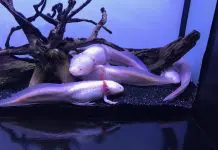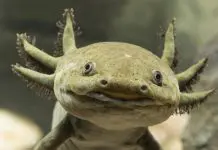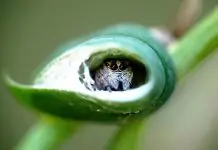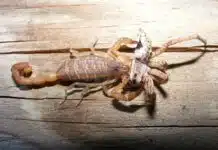Many people like the idea of having a snake for a pet but in reality, aren’t too happy at the prospect of feeding them live animals or having a few rodents stashed in their deep-freeze. Could the vegetarian egg-eating snake be the answer?
What snakes eat eggs? Can they be pets?
Although many snakes can, and do, eat eggs, the majority survive by eating other live prey too. Only the Indian egg-eating snake (elachistodon westermanni) and the African egg-eating snake (dasypeltis) have the specific biological make-up required to survive solely on birds’ eggs.
The Indian egg-eating snake is extremely rare and so the more common African egg-eating snake is the type usually found as a pet. There are several species of the African egg-eating snake; the most common for pet purposes is the rhombic egg-eater or common egg-eating snake (dasypeltis scabra).
Where can you find egg-eating snakes for sale?
If you wish to buy an egg-eating snake, it’s highly unlikely that your local pet store will be able to source one and they’re more usually obtained from exotic animal and reptile websites.
Their price varies but you can expect to pay around the US$100 mark. Delivery charges may be additional.
The breeding of these snakes in captivity is very unusual and so the vast majority of egg-eaters which become pets have been caught in the wild. Because of this, it’s a good idea to get your new pet checked over as soon as possible by a vet who specializes in exotic animals to make sure it’s healthy.
How big is an African egg-eating snake? How long do they live?
Egg-eaters are fairly small. The females will grow to about two to three feet, but the males are smaller. This is a huge factor in determining the size of eggs they eat as many eggs, including chicken eggs, will be too large for them.
Assuming that the snake’s treated well, a pet egg-eating snake is likely to live longer than a wild snake and can live for over ten years, although this will depend on various factors, including whether they are fed the correct type and size of egg, how good the snake’s appetite is and how often it’s fed, the state of their living conditions and whether they become sick.
Are egg-eating snakes venomous? Do they bite?
Egg-eating snakes are generally known for their placidity but in any event, they’re not venomous and have no teeth, both of which are bonuses if you’re thinking of getting one as a pet. Some can, however, be quite nervous, particularly when they’re new to captivity and may try to bite on occasion. Even if they do though, a toothless bite isn’t going to hurt.
When they feel nervous or threatened, the common egg-eating snake may also copy the venomous saw-scaled viper and rub their scales together. This makes a hissing noise but it’s nothing to worry about. If your pet egg-eater starts making this noise while you’re handling it, you’re best giving it some space as it’s probably feeling scared. Regular, gentle handling will usually calm the snake down over time. Remember, most of these snakes which become pets have been caught in the wild and haven’t got used to humans yet.
Egg-eating snake care
Egg-eating snakes are quite easy to look after, and setting up their vivarium doesn’t need to be too costly. They are curious creatures though so varying their surroundings regularly is a good idea. Moving things around inside the vivarium and maybe changing a branch or stone should keep them happy.
Vivarium
Make sure the vivarium is large enough to give your egg-eating snake sufficient space to move around and to contain everything it needs. It should be about the same length as your snake, so doesn’t need to be very large, and can be made from plastic, glass or wood. Plastic tubs are commonly used by experienced snake owners. Check that it has a tightly fitting lid that cannot be pushed off; egg-eating snakes are quite strong, and you don’t want your snake escaping.
Humidity
The African egg-eating snake comes from a dry environment and so doesn’t need particularly humid conditions. The humidity in the vivarium should be about 40 to 60%; a bowl of water in there should do the trick.
Temperature
Snakes need heat and the vivarium should have both a hot and cool area. The cool area can be around 21°C (69.8°F) and the hot area around 30°C (86°F). This will enable your pet snake to move around the vivarium and self-regulate its temperature as it would do in the wild.
Substrate
Sand or aspen shavings make a good substrate for these snakes. Although sand replicates their habitat in the wild, it can be tricky to clean. The substrate doesn’t need to be deep but must be kept fresh and fully replaced at least once a month.
Water
Pet snakes need to be given fresh water every day. This should be placed in a sturdy bowl to minimise the risk of your snake knocking it over.
Hides
Egg-eaters like to hide and feel secure and so you’ll need to include two hides in your vivarium, one at each end. These shouldn’t be too large; your snake should be able to curl up inside. Hides can be bought from pet shops or online or you could make your own; a toilet roll tube or small plant pot will do just as nicely. Giving your snake a moist hide when it’s shedding its skin will help the shedding process. You can fill this with sphagnum moss.
As you might expect from their dependency on birds’ eggs, African egg-eating snakes make good climbers and so it’s important to source some branches, stones and foliage for your snake to climb on and through in its vivarium. Don’t however, be tempted to take these from local wooded areas as they may have organisms on them which could be harmful to your pet snake.
Feeding an egg-eating snake
Type of eggs
The African egg-eating snake isn’t large and so can only eat small eggs. A general rule of thumb is that the size of the egg should be about equal to the width of the snake. As a result, sourcing eggs of the correct size is probably the most difficult issue with having an egg-eating snake as a pet.
Some snake owners suggest syringe-feeding your snake if you can’t access the right size of eggs for them. This shouldn’t be attempted unless you have experience in doing so as the snake can inhale the contents of the egg and could be seriously harmed as a result.
Adult females can generally be fed with Coturnix quail eggs, which can often be found in supermarkets. However, young snakes or males, which are smaller than the females, may require button quail eggs or finch eggs, and these can be difficult to find. Some people breed button quails or finches primarily to feed their snake the eggs. This is obviously quite extreme, and most people wouldn’t go to such lengths.
A frequent question is whether these snakes eat chicken eggs? The answer is no, regular chicken eggs are too big for them and you shouldn’t feed them to your pet egg-eating snake.
Fresh and undeveloped eggs
The eggs must be fresh otherwise the egg-eater won’t eat them; they detect an egg which is too old by its smell. If you keep the eggs in the refrigerator, make sure they’ve warmed to room temperature by the time you feed them to your snake; they wouldn’t eat refrigerated eggs in the wild.
Egg-eaters won’t eat fertilized eggs. This shouldn’t be an issue if you buy your eggs from the supermarket or a local supplier. However, if you decide to breed your own birds to provide a food source for your snake, remember to remove the eggs as soon as they’re laid to ensure that your snake is only given undeveloped eggs.
Swallowing eggs
The way in which the African egg-eating snake swallows a whole egg is mesmerising to watch. They have a flexible skull and stretchy skin, and this allows them to swallow an egg much larger than the size of their heads.
Above the snake’s oesophagus, on its vertebrae, there are spikes called hypapophyses, which enables the snake to crush the egg. The spikes are housed inside folds to prevent them from digging into the oesophagus. Once crushed, the snake will swallow the contents of the egg and then regurgitate the shell.
How and when do you feed eggs to an egg-eating snake?
It’s important that your snake doesn’t eat any of the substrates in its vivarium while swallowing the egg. Because of this, you’re best to either place the egg in a separate clean dish in the vivarium or ideally, feed your snake outside of the vivarium in a separate clean container.
Some people simply place the egg in the container but if you want to get creative and give your snake some exercise, hide the egg in some branches or make your own bird’s nest to hold the egg for your snake to find.
After your snake’s eaten, it’s important that you remember to promptly remove the regurgitated shell from the vivarium.
If you wish to imitate your snake’s feeding pattern in the wild, you’ll need to feed your snake as much as it wants for several months. This may result in it eating a few eggs each week. You would then enforce a “wet season” during which time you wouldn’t feed your snake at all.
An alternative method is to feed your snake one egg each week, although bear in mind that these snakes can last for months without eating at all and adult snakes will eat less often than young snakes. If your snake doesn’t take its weekly egg, try again a week later. Another way to encourage eating is to make the egg smell like a bird’s nest by rubbing chicken egg yolk over it.
If your snake remains off its food but is still drinking plenty, shedding its skin and acting normally, it’s likely to be fine and you shouldn’t be overly concerned.
Egg-eating snakes are nocturnal
Egg-eating snakes are nocturnal and tend to be active at night. You should bear this in mind when considering whether to purchase one as a pet. If you’re not a night-owl yourself, you may find that you don’t actually see much activity from your pet snake.
When will my egg-eater shed its skin?
All snakes shed their skin. This process is called ecdysis. Your egg-eating snake will do this several times a year, although younger snakes shed more often. If your snake has difficulty shedding its skin or doesn’t seem to be doing so, try increasing the humidity in its vivarium. If this doesn’t help, you should take it to a vet, preferably one who specialises in exotic animals.
Do egg-eating snakes lay eggs?
Egg-eating snakes are oviparous and so lay eggs. Each egg is laid in a separate place. Egg-eating snakes won’t eat their own eggs but it’s a good idea to remove them from the vivarium anyway and keep them separately. The mother snake won’t nest or look after her eggs and doesn’t have any maternal instinct. In fact, having the baby snakes in the same vivarium as their mother might cause stress as snakes prefer to be on their own.
Final Thoughts: Do African egg-eating snakes make good pets?
The positives of keeping an egg-eating snake as a pet:
- They only eat eggs, so there’s no need to feed them live rodents or other animals, or to have frozen prey in your deep-freeze
- They remain small, up to two to three feet long
- Compared to other snakes, they’re easy to look after as they don’t require particularly high temperatures or humidity
- They’re placid, have no teeth and aren’t venomous
The negatives of keeping an egg-eating snake as a pet:
- It can be difficult to source the eggs for them to feed on, especially if you have a young snake or a male, which are smaller than the females
- They can be nervous, particularly to begin with and may not like being handled
- They’re nocturnal so you might not see much activity from them
If you wish to keep an egg-eating snake as a pet, it’s crucial that you do your research first and ensure that you can source the right size of eggs for them. If you can do this and are happy to have a nocturnal pet, African egg-eating snakes can make excellent, albeit rather unusual, pets.


![Sick Axolotl, Fungus, Stress Symptoms [Axolotl Illness Guide 2024] Axolotl fungus](https://exopetguides.com/wp-content/uploads/2018/06/axolotl-218x150.jpg.webp)
















